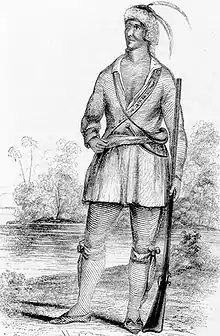Chief Thlocklo Tustenuggee | |
|---|---|
 | |
| Nickname(s) | Tiger Tail |
| Died | Near Miami River in Florida, United States of America |
| Allegiance | Seminole Tribe of Florida |
| Battles/wars | |
Thlocklo Tustenuggee (also known as Thlocko, Thlocco, and Tiger Tail) was one of the most prominent Seminole leaders in the Second Seminole War. He spoke English fluently,[1] and also spoke Muscogee.[2] Tustenuggee was one of the three leaders of the 300 Seminoles who fought in the battle that became known as the Dade Massacre.[3] During the war, he and Halleck Tustenuggee, another prominent Seminole leader in the war, met with General Walker Keith Armistead to negotiate, but negotiations broke down and the war resumed.[4] As the war waned, Armistead used money to bribe several Seminole leaders to surrender, but Tustenuggee refused to be bribed and he continued to lead his band in fighting.[5] When the war ended, his Seminole band was one of the few that remained in Florida.[6]
Tustenuggee's final years and death are debated by historians. By November 1842, it seemed that the Seminole Chief was willing to gave in and accept forced emigration. A contemporary, John Sprague, wrote that Tustenuggee died immediately after arriving in New Orleans on his way west. Alternatively, others claim that rather than leave Florida, Tustenuggee committed suicide in Fort Myers by swallowing powdered glass.[7] Another author stated that Tustenuggee never left Florida and evaded capture because U.S. troops found a body that resembled the chief but was not him (the body was reportedly disfigured from a drunken brawl, thus making identification difficult).[8] The last report was an obituary from the Tallahassee Floridian, published in October 1881, which stated that Tiger Tail died at about the age of 90 somewhere near Miami the previous month.[9]
References
- ↑ Joseph Norman Heard (1987). Handbook of the American Frontier: The Southeastern Woodlands. Rowman & Littlefield. p. 359. ISBN 0810819317.
- ↑ Dan Ryan (2011). Merryweather: USMC. AuthorHouse. p. 82. ISBN 978-1463414450.
- ↑ John C. Fredriksen (1999). American Military Leaders. ABC-CLIO. p. 559. ISBN 1576070018.
- ↑ Adam Wasserman (2009). A People's History of Florida, 1513-1876: How Africans, Seminoles, Women, and Lower Class Whites Shaped the Sunshine State. Adam Wasserman. p. 300. ISBN 978-1442167094.
- ↑ Ralph Van Blarcom (2011). Seminole War Artifacts and a History of the Forts of Florida. Xlibris. p. 24. ISBN 978-1462877430.
- ↑ Ron Field (2009). The Seminole Wars, 1818-58. Osprey Publishing. p. 18. ISBN 978-1846034619.
- ↑ Staff Writer (December 4, 2010). "How Did Tiger Tail Really Die?". The Ledger. Retrieved 6 November 2023.
- ↑ Williams, Isabella M. (1925). "The Truth Regarding "Tiger-Tail"". Florida Historical Quarterly. 4 (2): 72–75. Retrieved 6 November 2023.
- ↑ Staff Writer 2010.